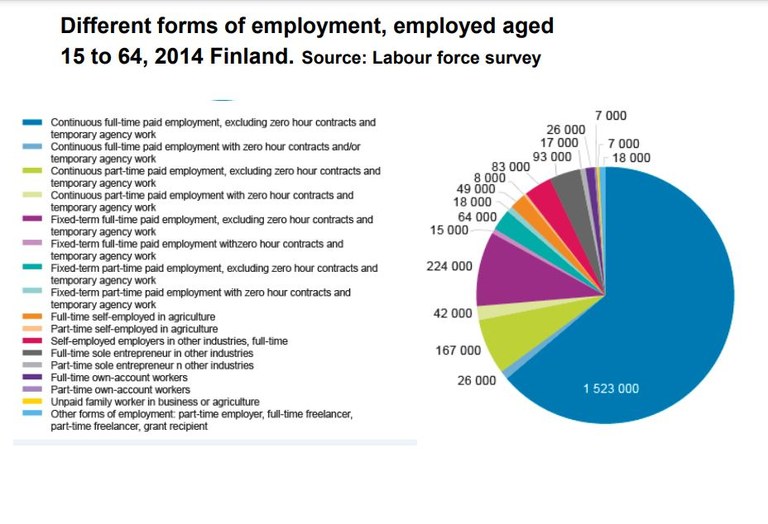17 types of employment – and the rest
The Nordics have not become a region of freelancers, but there is a growing multitude of different forms of labour. The Corona pandemic has also made life for people with non-standard work even more precarious, confirmed experts at a Nordic conference on the future of work.
Nordic cities have a plethora of bicycle or moped food delivery services, clearly visible with their company logos and carrying big, square bags on their backs. While bags and working tasks are the same across different companies, the workers’ job conditions differ. Those with blue bags work for Wolt and are not covered by any collective agreement. Riders with pink bags work for Foodora and are covered – but only in Norway.
“The future is here"
The cycling food delivery workers are but one example of many new types of jobs that are offered and carried out by Nordic citizens in new and very different ways – typically with much flexibility and without the job and pay protection traditional employees enjoy. Such as collective agreements securing a decent salary, the right working hours, paid holidays and pensions.
A Nordic online conference held in November 2020 focused on these new types of labour. It was organised by the Nordic Council of Ministers to present the results of the joint Nordic research project “Nordic Future of Work” which has been running for several years.
Denmark currently holds the Presidency of the Nordic Council of Ministers, and the conference was opened by Denmark’s Minister of Employment Peter Hummelgaard. He praised the report and the conference for highlighting how Nordic labour markets and the Nordic labour market model can tackle the major changes facing the labour market – including new types of employment.
“The future of work is already a reality in the Nordic region,” the minister said, alluding to digitalisation, new technologies and new forms of employment.
Unchanged scope but new types of labour
The researchers behind the report ”Nordic Future of Work” have made several new discoveries, including the fact that the number of people in non-standard work has not risen for a good while. As new forms of non-standard employment began to emerge a few years ago, many predicted that the Nordics would turn into a region of freelancers.
Yet the Nordic Future of Work report shows that that prophecy has not come true, said Anna Ilsøe, Associate Professor at the Employment Relations Research Centre (FAOS) at the University of Copenhagen.
She and her colleague Trine Larsen have coordinated the Danish part of the Nordic Future of Work report.
“It surprised us that the scope of non-standard work has largely remained unchanged over the past 20 years. But we also found that there are troubled waters under the still surface,” Anna Ilsøe told the conference.

Anna Ilsøe and Trine Larsen, FAOS, Anna Pärnänen, Statistics Finland
Even though the scope of non-standard work has not grown, many Nordic citizens have this type of jobs – between one in three and one in four of workers do not have permanent full-time work with at least 30 hours a week. Many combine several income streams and have several different forms of employment – often temporary jobs with few or no guaranteed hours, also known as zero-hours contracts. The researchers’ case studies in Denmark, Sweden and Finland show that up to 50% of people working in care homes and hotels are on such contracts.
Non-standard employment is particularly widespread in the hospitality sector, retail and cleaning as well as in the event and creative industries, where time-limited contracts and freelance jobs are common.
The researchers see two opposite trends among businesses – some make use of even more forms of non-standard work, others are beginning to offer people in non-standard jobs more employment safety and security.
A need for more security
The researchers from FAOS said people in non-standard jobs face a lot of job and income insecurity, and many of them are involuntarily in this type of employment. 70% of temporary workers in Sweden, Norway and Finland have not chosen this voluntarily.
The Corona crisis has had a very negative effect on job and income security among people with non-standard work, Trine Larsen explains.
“People in non-standard employment have been particularly hard hit by Corona because many of them work in sectors that have struggled because of the crisis.”
It has also proven difficult for many in non-standard work to benefit from state help introduced by Nordic authorities to help the labour market through the crisis. Yet there are some positive signs here too, according to Trine Larsen.
“Nordic governments and the social partners have launched a range of initiatives aimed at people in non-standard work, as well as new innovative social security measures. But despite the Nordic governments’ good intentions, we see that many people in non-typical employment still struggle and face higher job and income insecurity.”

Senior Researcher Annan Pärnanen from Statistics Finland tried to illustrate the development in the number of different types of employment for the conference participants in a graph. Not an easy task, she confessed.
“I have tried to divide the Finnish workforce’s employment forms into categories, and have arrived at 17. I admit that this makes it nearly impossible to read, and this does reflect how complex the number of different forms of employment has become.”
 Follow us on Facebook
Follow us on Facebook
